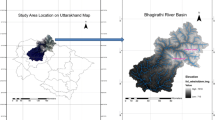Abstract
This study proposes an improved fuzzy time series (IFTS) forecasting model using variations of data that can interpolate historical data and forecast the future. The parameters in this model are chosen by algorithms to obtain the most suitable values for each data set. The calculation of the IFTS model can be performed conveniently and efficiently by a procedure within the R statistical software that has been stored in the AnalyseTS package. The proposed model is also used in the forecasting of two real problems in Vietnam: the penetration of salt and the total population. These numerical examples show the advantages of the proposed model in comparison with existing models and illustrate its effectiveness in practical applications.




Similar content being viewed by others
References
Abbasov, A., & Mamedova, M. (2003). Application of fuzzy time series to population forecasting. Vienna University of Technology, 1, 545–552.
Abreu, P. H., Silva, D. C., Mendes-Moreira, J., Reis, L. P., & Garganta, J. (2013). Using multivariate adaptive regression splines in the construction of simulated soccer team’s behavior models. International Journal of Computational Intelligence Systems, 6(5), 893–910.
Aladag, S., Aladag, C. H., Mentes, T., & Egrioglu, E. (2012). A new seasonal fuzzy time series method based on the multiplicative neuron model and SARIMA. Hacettepe Journal of Mathematics and Statistics, 41(3), 145–163.
Bas, E., Uslu, V. R., Aladag, C., Yolcu, U., & Egrioglu, E. (2014). A modified genetic algorithm for forecasting fuzzy time series. Applied Intelligence, 41, 453–463.
Chen, S. M. (2002). Forecasting enrollments based on high-order fuzzy time series. Cybernetics and Systems: An International Journal, 33, 1–16.
Chen, S. M., & Chen, D. C. (2011). TAIEX forecasting based on fuzzy time series and fuzzy variation groups. IEEE Transactions on Fuzzy Systems, 19, 1–12.
Chen, S. M., & Kao, P. Y. (2013). TAIEX forecasting based on fuzzy time series, particle swarm optimization techniques and support vector machines. Information Sciences, 247, 62–71.
Chen, S. M., & Tanuwijaya, K. (2011). Fuzzy forecasting based on high-order fuzzy logical relationships and automatic clustering techniques. Expert Systems with Applications, 38, 15425–15437.
Chen, T. L., & Shiu, S. Y. (2007). A new clustering algorithm based on self-updating process. In JSM proceedings, statistical computing section, Salt Lake City, Utah (pp. 2034–2038).
Egrioglu, S., Bas, E., Aladag, C. H., & Yolcu, U. (2016). Probabilistic fuzzy time series method based on artificial neural network. American Journal of Intelligent Systems, 62(2), 42–47.
Friedman, J. H. (1991). Multivariate adaptive regression splines. Annals of Statistics, 19(1), 1–141.
Ghosh, H., Chowdhury, S., & Prajneshu, S. (2015). An improved fuzzy time series method of forecasting based on L-R fuzzy. Journal of Applied Statistics, 43(6), 1128–1139.
Huarng, K. (2001). Heuristic models of fuzzy time series for forecasting. Fuzzy Sets and Systems, 123(3), 369–386.
Huarng, H., & Yu, T. H. K. (2006). The application of neural networks to forecast fuzzy time series. Physica A, 363, 481–491.
Khashei, M., Bijari, M., & Hejazi, C. S. R. (2011). An extended fuzzy artificial neural networks model for time series forecasting. Iranian Journal of Fuzzy Systems, 8(3), 45–66.
Lee, H. S., & Chout, M. T. (2004). Fuzzy forecasting based on fuzzy time series. International Journal of Computer Mathematics, 81(7), 781–789.
Liu, H. T., Wei, N. C., & Yang, C. G. (2009). Improved time-variant fuzzy time series forecast. Fuzzy Optim Decis Making, 8, 45–65.
Oliveira, D. J & Ludermir, T. B. (2014). A distributed PSO-ARIMA-SVR hybrid system for time series forecasting. In 2014 IEEE international conference on systems, man, and cybernetics (SMC) (pp. 3867–3872).
Singh, S. R. (2007). A simple method of forecasting based on fuzzy time series. Applied Mathematics and Computation, 186(1), 330–339.
Song, Q., & Chissom, B. S. (1993). Fuzzy time series and its models. Fuzzy Sets and Systems, 54(3), 269–277.
Spyros, M., & Michle, H. (2000). The M3-competition: Results, conclusions and implications. International Journal of Forecasting, 16, 451–476.
Teoh, H. J., Cheng, C. H., Chu, H. H., & Chen, J. S. (2008). Fuzzy time series model based on probabilistic approach and rough set rule induction for empirical research in stock markets. Data & Knowledge Engineering, 67(1), 103–117.
Yu, H. K. (2005). Weighted fuzzy time-series models for TAIEX forecasting. Physica A, 349, 609–624.
Yu, H. K., & Huarng, K. (2010). A neural network- based fuzzy time series model to improve forecasting. Expert Systems with Application, 37, 3366–3372.
Author information
Authors and Affiliations
Corresponding author
Rights and permissions
About this article
Cite this article
Vovan, T. An improved fuzzy time series forecasting model using variations of data. Fuzzy Optim Decis Making 18, 151–173 (2019). https://doi.org/10.1007/s10700-018-9290-7
Published:
Issue Date:
DOI: https://doi.org/10.1007/s10700-018-9290-7




